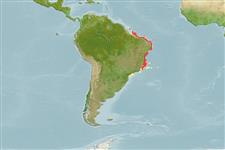Teleostei (teleosts) >
Gobiiformes (Gobies) >
Gobiidae (Gobies) > Gobiinae
Etymology: Elacatinus: Greek, elakatines = fusiform fishes preserved in salt (Ref. 45335); pridisi: Named for the Brazilian Navy First District (Primeiro Distrito Naval, Marinha do Brasil - "PRIDIS").
Eponymy: Not an eponym but in honour of the Brazilian Navy First District (Primeiro Distrito Naval, Marinha do Brasil, or ‘PRIDIS’), for the “…impeccable logistic support” provided during the authors’ field trips to Trindade Island, off Brazil, the type locality. (Ref. 128868), visit book page.
Environment: milieu / climate zone / depth range / distribution range
Ecology
Marine; demersal; depth range 3 - 30 m (Ref. 52745). Tropical
Southwest Atlantic: Trinidade Island, Brazil.
Size / Weight / Age
Maturity: Lm ? range ? - ? cm
Max length : 2.8 cm SL male/unsexed; (Ref. 52745)
Short description
Identification keys | Morphology | Morphometrics
Dorsal soft rays (total): 11 - 12; Anal soft rays: 11. Diagnosis: This species differs from its congeners of the Horsti complex (sensu Böhlke & Robins 1968) that have a pale stripe extending from the eye to the caudal-fin base by the following combination of characters: dark longitudinal stripe wide, reaching lower abdomen and base of anal-fin (vs. never reaching abdomen or base of anal fin); pectoral-fin rays typically 18 (vs. typically 17 in E. randalli and E. figaro and typically 16 in E. atronasum (Böhlke & Robins); anal-fin rays typically 11 (vs. typically 10 in E. figaro); oval spot present on snout (vs. no spot in E. atronasum and E. horsti (Böhlke & Robins), a "V"-shaped spot in E. prochilos (Böhlke & Robins), and a medial bar in E. xanthiprora (Böhlke & Robins), E. louisae (Böhlke & Robins) and E. lori Colin) (Ref. 52745).
Found over rocky reefs and calcareous-algae banks around the island. Observed in cleaning activities during the day (and most of its life-cycle) with clients varying from large-sized carnivores such as Carcharhinus perezi (Poey) to small-sized planktivores such as Chromis multilineata (Guichenot) (Ref. 52745).
Life cycle and mating behavior
Maturity | Reproduction | Spawning | Eggs | Fecundity | Larvae
Guimarães, R.Z.P., J.L. Gasparini and L.A. Rocha, 2004. A new cleaner goby of the Elacatinus (Teleostei: Gobiidae), from Trinidade Island, off Brazil. Zootaxa 770:1-8. (Ref. 52745)
IUCN Red List Status (Ref. 130435: Version 2024-2)
Threat to humans
Harmless
Human uses
Tools
Special reports
Download XML
Internet sources
Estimates based on models
Phylogenetic diversity index (Ref.
82804): PD
50 = 0.5000 [Uniqueness, from 0.5 = low to 2.0 = high].
Bayesian length-weight: a=0.00724 (0.00339 - 0.01546), b=3.10 (2.92 - 3.28), in cm total length, based on LWR estimates for this (Sub)family-body shape (Ref.
93245).
Trophic level (Ref.
69278): 3.3 ±0.3 se; based on size and trophs of closest relatives
Resilience (Ref.
120179): High, minimum population doubling time less than 15 months (Preliminary K or Fecundity.).
Fishing Vulnerability (Ref.
59153): Low vulnerability (10 of 100).
